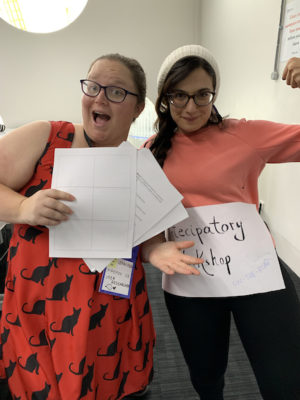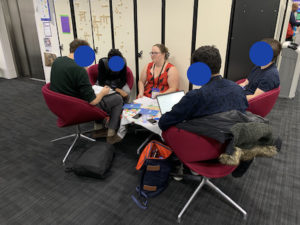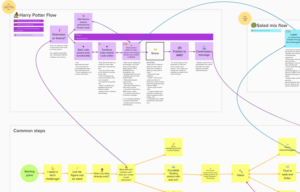Sometimes, when you’re doing user research, things just don’t quite go as planned. MozFest was one of those times for us.
MozFest, the Mozilla Festival, is a vibrant conference and week-long “celebration for, by, and about people who love the internet.” Held at a Ravensbourne university in London, the festival features nine floors of simultaneous sessions. The Add-ons UX team had the opportunity to host a workshop at MozFest about co-designing a new submission flow for browser extensions and themes. The workshop was a version of the Add-ons community workshop we held the previous day.
On the morning of our workshop, we showed up bright-eyed, bushy-tailed, and fully caffeinated. Materials in place, slides loaded…we were ready. And then, no one showed up.
Perhaps because 1) there was too much awesome stuff going on at the same time as our workshop, 2) we were in a back corner, and 3) we didn’t proactively advertise our talk enough.
After processing our initial heartache and disappointment, Emanuela, a designer on the team, suggested we try something we don’t do often at Mozilla, if at all: guerrilla research. Guerrilla user research usually means getting research participants from “the street.” For example, a researcher could stand in front of a grocery store with a tablet computer and ask people to use a new app. This type of research method is different than “normal” user research methods (e.g. field research in a person’s home, interviewing someone remotely over video call, conducting a usability study in a conference room at an office) because there is much less control in screening participants, and all the research is conducted in the public eye [1].
Guerrilla research is a polarizing topic in the broader user research field, and with good reason: while there are many reasons one might employ this method, it can and is used as a means of getting research done on the cheap. The same thing that makes guerrilla research cheaper—convenient, easy data collection in one location— can also mean compromised research quality. Because we don’t have the same level of care and control with this method, the results of the work can be less effective compared to a study conducted with careful recruitment and facilitation.
For these reasons, we intentionally don’t use guerrilla research as a core part of the Firefox UX practice. However, on that brisk London day, with no participants in sight and our dreams of a facilitated session dashed, guerrilla research presented itself as a last-resort option, as a way we could salvage some of our time investment AND still get some valuable feedback from people on the ground. We were already there, we had the materials, and we had a potential pool of participants—people who, given their conference attendance, were more informed about our particular topic than those you would find in a random coffee shop. It was time to make the best of a tough situation and learn what we could.
And that’s just what we did.
Thankfully, we had four workshop facilitators, which meant we could evolve our roles to the new reality. Emanuela and Jennifer were traveling workshop facilitators. Phil, another designer on the team, took photos. Meridel, our content strategist, stationed herself at our original workshop location in case anyone showed up there, taking advantage of that time to work through content-related submission issues with our engineers.

A photo of Jennifer and Emanuela taking the workshop “on the road
We boldly went into the halls at MozFest and introduced ourselves and our project. We had printouts and pens to capture ideas and get some sketching done with our participants.

A photo of Jennifer with four participants
In the end, seven people participated in our on-the-road co-design workshop. Because MozFest tends to attract a diverse group of attendees from journalists to developers to academics, some of these participants had experience creating and submitting browser extensions and themes. For each participant we:
- Approached them and introduced ourselves and the research we were trying to do. Asked if they wanted to participate. If they did, we proceeded with the following steps.
- Asked them if they had experience with extensions and themes and discussed that experience.
- Introduced the sketching exercise, where we asked them to come up with ideas about an ideal process to submit an extension or theme.
- Watched as the participant sketched ideas for the ideal submission flow.
- Asked the participant to explain their sketches, and took notes during their explanation.
- Asked participants if we could use their sketches and our discussion in our research. If they agreed, we asked them to read and sign a consent form.
The participants’ ideas, perspectives, and workflows fed into our subsequent team analysis and design time. Combined with materials and learnings from a prior co-design workshop on the same topic, the Add-ons UX team developed creator personas. We used those personas’ needs and workflows to create a submission flow “blueprint” (like a flowchart) that would match each persona.

A snippet of our submission flow “blueprint”
In the end, the lack of workshop attendance was a good opportunity to learn from MozFest attendees we may not have otherwise heard from, and grow closer as a team as we had to think on our feet and adapt quickly.
Guerrilla research needs to be handled with care, and the realities of its limitations taken into account. Happily, we were able to get real value out of our particular application, with note that the insights we gleaned from it were just one input into our final deliverables and not the sole source of research. We encourage other researchers and designers doing user research to consider adapting your methods when things don’t go as planned. It could recoup some of the resources and time you have invested, and potentially give you some valuable insights for your product design process.
Acknowledgements
Much gratitude to our colleagues who created the workshop with us and helped us edit this blog post! In alphabetical order, thanks to Stuart Colville, Mike Conca, Kev Needham, Caitlin Neiman, Gemma Petrie, Mara Schwarzlose, Amy Tsay, and Jorge Villalobos.
Reference
[1] “The Pros and Cons of Guerrilla Research for Your UX Project.” The Interaction Design Foundation, 2016, www.interaction-design.org/literature/article/the-pros-and-cons-of-guerrilla-research-for-your-ux-project.
Also published on medium.com.